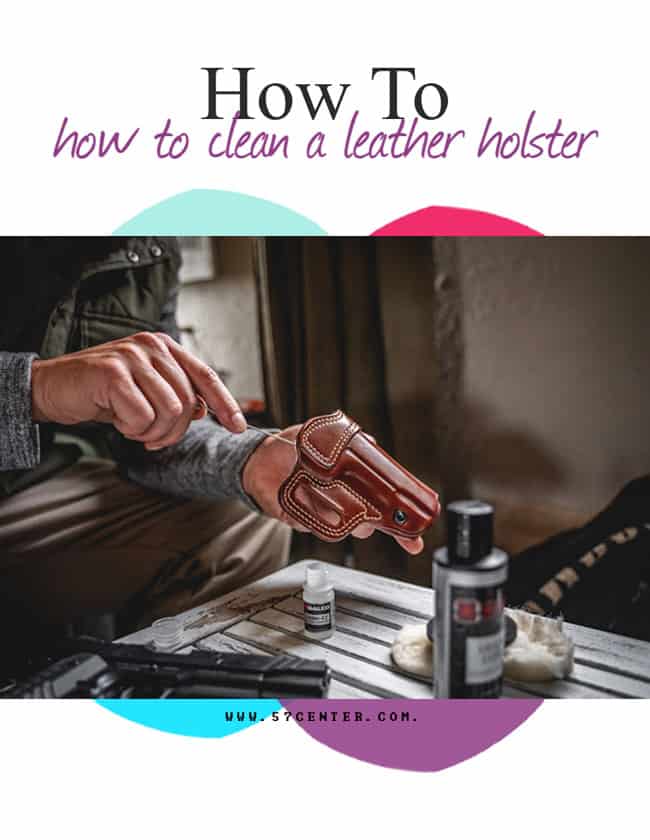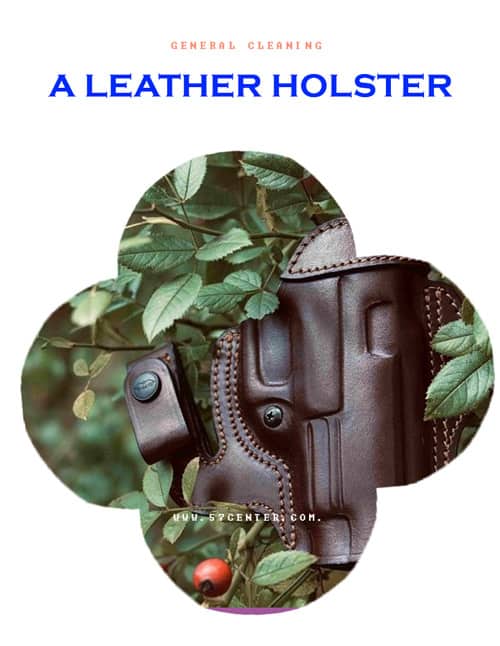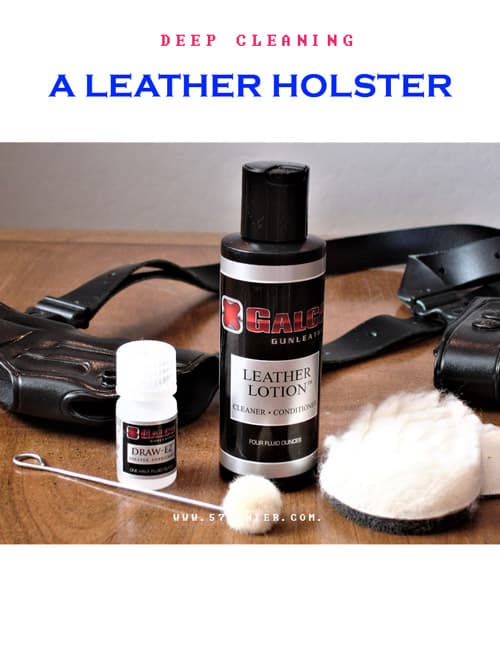
Leather holsters are an old-time favorite for gun owners. Leather products are beautiful and durable, and provide a comfortable holster and a neat fit on your gun belt. They are favorited by shooters because they tend to be more comfortable than synthetic holsters. However, with the quality comes some maintenance. Leather holster care is very easy to maintain so there’s no reasons your firearm should be resting in a cracked holster.
Holster leather is exposed to many factors that can wear it down and dirty it over time. That’s why holster maintenance is so important. Especially if you are a constant carrier, your leather will get dirty and will be exposed to sun, rain, snow, you name it. All these things can ruin your leather goods faster than you might think; leather care is important to preserve the functionality of your leather item.
Contents
When Should I Clean My Holster?
Just like everything else you own, your clothes, your counters, and even your handgun, your holster needs to be cleaned periodically too. If anything, your holster is essentially just another clothing item. Especially when you concealed carry, your holster is constantly being worn and is exposed to your body and other conditions that can get it all gunked up over time. An IWB holster is more prone to getting smelly because it soaks up a lot of your sweat and other grime that might get rubbed off your skin. If anything, you’ll want to clean your holster to keep it sanitary too.
Just think of it this way. You have to clean your gun to make sure it functions well, right? You wouldn’t want to put your shiny, newly cleaned gun into a dirty holster, would you?
Here’s the good news. You don’t have to clean your holster every day like you brush your teeth. Typically, it’s best to clean it every 2 weeks or so, just to keep it in generally good conditions. Once a month, you should disassemble the holster and go over it with some oils and leather conditioner to keep it in top shape.
Cleaning Tools and Products:
Before you embark on cleaning your leather holster, gather the necessary tools and products. Here’s what you’ll need:
- Soft bristle brush: Use a brush with soft bristles to gently remove dirt and debris from the holster’s surface.
- Mild soap: Choose a mild soap specifically formulated for cleaning leather. Avoid harsh chemicals or abrasive cleaners that can damage the material.
- Distilled water: Distilled water is preferred for cleaning leather holsters as it doesn’t contain impurities that could harm the leather.
- Soft, lint-free cloth: Use a soft cloth to apply soap and water to the holster and to gently wipe it dry after cleaning.
Recommendation: We recommend using a high-quality leather cleaner, such as “LeatherGuard Holster Cleaner,” which is specially designed for cleaning and maintaining leather holsters. It effectively removes dirt, stains, and oils without compromising the integrity of the leather.
Step-by-Step Cleaning Process:
Follow these steps to clean your leather holster effectively:
Step 1: Remove the gun from the holster: Ensure the gun is safely unloaded and remove it from the holster before cleaning.
Step 2: Brush off loose dirt: Use a soft bristle brush to gently brush off any loose dirt or debris from the surface of the holster.
Step 3: Prepare a cleaning solution: Mix a small amount of mild soap with distilled water to create a gentle cleaning solution.
Step 4: Apply the cleaning solution: Dampen a soft cloth with the cleaning solution and gently rub it onto the leather surface. Avoid saturating the holster with excessive moisture.
Step 5: Clean hard-to-reach areas: Use a cotton swab or a soft-bristled brush to clean hard-to-reach areas, such as creases or stitching.
Step 6: Rinse with distilled water: Dampen another cloth with distilled water and gently wipe away any soap residue from the holster.
Step 7: Dry the holster: Use a clean, dry, lint-free cloth to gently pat the holster dry. Avoid using heat sources to speed up the drying process, as they can cause the leather to crack.
General Cleaning

First, we’ll talk about general cleaning. General cleaning is something you should do every 2 weeks to keep your holster clean and sanitary. Doing a quick wipe down will ensure that your leather product will be less prone to wear and tear in the future. This is especially important if you have an old leather holster; older products are typically more worn down already, so it’s important to keep up on maintenance to preserve its life as long as possible.
For this type of cleaning, using a soft cloth with some warm water to clean it. This will generally suffice. If you want to clean deeper or there’s some tough grease that won’t seem to come out, you can use glycerin soap to give it a good shine. Glycerin soap, also known as saddle soap, is specially formulated to be a leather cleaner and will leave your holster with a smooth and shiny finish.
Saddle soap is for general leather so it can also serve as a cleaner for leather boots, a leather belt, and a leather sheath. While leather friendly, it’s pretty concentrated since it’s pure glycerin soap, and should be used accordingly. A small amount will do wonders for your holster.
Now, it’s pretty common for people to ask if you can use vinegar to clean your leather goods. Unfortunately, while it is a great cleaning liquid, it can dry out your leather holster and leave it cracked or even ruined. So it’s best to stay away from vinegar when it comes to any type of leather item.
To use the soap, gently rub it into the leather holster with a soft cloth. Once you’ve covered the whole thing, set the holster aside until it’s completely dry.
If you’re just doing a general cleaning, then that’s all you’ll have to do for now. You can go back to using your holster just like normal. If you’re wanting to do a deep clean, let’s talk about the steps to take for that.
Deep Cleaning

Deep cleaning leather involves much more than just using glycerin soap. It also involves leather maintenance and conditioner, and even care for the kydex parts of your holster. While you might have a 100% leather holster, a lot of more modern holsters come with edges or spots that might be reinforced with kydex for extra strength and durability. Kydex is no different; it should be taken care of with the same attention as the leather.
Once your leather has been cleaned with saddle soap and dried, you’ll want to grab some leather conditioner. Make sure your product is formulated specifically for holsters; too much conditioner or products that aren’t right can soften the holster too much and it will lose it’s functionality.
Your leather conditioner will be some type of oil. Neatsfoot oil, mink oil, and olive oil are some good choices if you don’t have an actual leather care product on hand. However, just remember: use them sparingly. Too much oil will soften and ruin your holster. A lot of leather holsters are actually shipped with a small bottle of leather conditioner or oil that will last you the entire time that you use your holster.
This is the important part. You should ONLY apply the oil to the gun side of your holster. That part of the leather is the section that takes the most wear and tear and is the only side that will be needing oil treatment. The outer part of the leather holster is already constantly being conditioned by the natural oil from your skin; applying oil to this part can make it too soft. If you don’t have an IWB holster and feel that the outside of your leather is becoming brittle or dry, that’s when you can apply a small amount of the oil to it.
I can’t stress this enough. A small amount will go a long way. Massage the small amount of oil into your holster where it needs it and give it some time to soak in.
Now, if your holster has any kydex components, those are pretty low maintenance. Just take a damp cloth and give the kydex material a good solid wipe down; that’s all you’ll need to do.
Besides that, just do a general examination of your holster. Most holsters have some sort of metal parts or clips, just like your belt, that should be checked for rust or other forms of wear.
You’re done! For deep cleaning your holster, you only need to do it about once a month. That includes cleaning, conditioning, and checking the other parts for rust or dirt.
Dos and Don’ts of Leather Holster Maintenance:
To maintain the quality and durability of your leather holster, keep the following dos and don’ts in mind:
Dos:
- Store your leather holster in a cool, dry place away from direct sunlight or heat sources.
- Use a leather conditioner periodically to keep the leather moisturized and supple.
- Test any cleaning or conditioning product on a small, inconspicuous area before applying it to the entire holster.
Don’ts:
- Avoid using harsh chemicals, alcohol-based cleaners, or solvents on your leather holster, as they can cause irreversible damage.
- Never submerge your leather holster in water or expose it to excessive moisture.
- Avoid placing heavy objects on top of your leather holster, as it can deform its shape.
Regular Care and Preservation:
Regular care is essential to extend the lifespan of your leather holster. Here are some additional steps you can take for optimal care and preservation:
- Avoid excessive exposure to water: While leather holsters can withstand some moisture, prolonged exposure to water can cause the leather to warp or lose its shape. Keep your holster away from rain or water sources.
- Apply a leather conditioner: Every few months, apply a small amount of leather conditioner to keep the leather hydrated. This prevents it from drying out and cracking.
- Protect against scratches: Use a leather protectant spray or wax to create a protective layer on the holster’s surface, reducing the risk of scratches and abrasions.
- Remove stains promptly: If you notice any stains on your leather holster, clean them immediately using the steps mentioned earlier. Prompt action can prevent stains from setting into the leather.
Conclusion:
Cleaning and maintaining a leather holster is vital for its longevity and functionality. By following the step-by-step guide and implementing the dos and don’ts mentioned in this article, you can ensure that your leather holster remains in excellent condition. Regular care and preservation will protect your investment and provide a reliable and safe carrying solution for your firearm.
Frequently Asked Questions:
- Can I use regular soap or household cleaners to clean my leather holster? Using regular soap or household cleaners is not recommended for cleaning leather holsters, as they can damage the material. It’s best to use a mild soap specifically formulated for leather cleaning.
- How often should I clean my leather holster? The frequency of cleaning depends on how often you use your leather holster and the environmental conditions it’s exposed to. Generally, cleaning every few months or when visibly dirty is sufficient. Regularly inspect your holster for any signs of dirt or stains.
- Can I speed up the drying process of my leather holster with a hairdryer or other heat sources? No, it’s not advisable to use heat sources like hairdryers to speed up the drying process. Excessive heat can cause the leather to crack or warp. Instead, let your leather holster air dry naturally at room temperature.
- What should I do if my leather holster gets wet? If your leather holster gets wet, gently pat it dry with a clean cloth and let it air dry naturally. Avoid using heat sources or direct sunlight, as they can damage the leather. Once it’s dry, apply a leather conditioner to restore its moisture.
- How can I remove stubborn stains from my leather holster? For stubborn stains, it’s best to consult a professional leather cleaner or seek advice from the manufacturer of your holster. They can provide specific guidance on stain removal without damaging the leather.
References
https://www.crossbreedholsters.com/blog/holster-maintenance-101/
https://www.handgunsmag.com/editorial/care-for-leather-holsters/138060
https://mitchrosen.com/products/additional-products/
https://rgrizzleleather.com/how-do-i-care-for-my-holster.html
https://www.wrightleatherworks.com/pages/care-maintenance

Brian Belko is a freelance writer and blogger. His primary areas of focus include the outdoors and shooting sports. In addition to his freelance work, Brian also writes for Wide Open Spaces and is on the Pro Staff at Military Hunting and Fishing. When he isn’t busy writing, Brian enjoys fishing farm ponds for bass and hitting the spring woods during turkey season.
